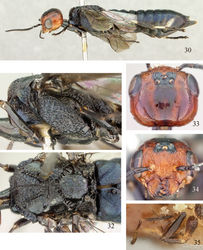Euxiphydria vietnamensis
| Notice: | This page is derived from the original publication listed below, whose author(s) should always be credited. Further contributors may edit and improve the content of this page and, consequently, need to be credited as well (see page history). Any assessment of factual correctness requires a careful review of the original article as well as of subsequent contributions.
If you are uncertain whether your planned contribution is correct or not, we suggest that you use the associated discussion page instead of editing the page directly. This page should be cited as follows (rationale):
Citation formats to copy and paste
BibTeX: @article{Smith2011JournalofHymenopteraResearch23, RIS/ Endnote: TY - JOUR Wikipedia/ Citizendium: <ref name="Smith2011Journal of Hymenoptera Research23">{{Citation See also the citation download page at the journal. |
Ordo: Hymenoptera
Familia: Xiphydriidae
Genus: Euxiphydria
Name
Euxiphydria vietnamensis Smith & Shinohara sp. n. – Wikispecies link – ZooBank link – Pensoft Profile
Holotype
Female, labeled “Deo O Quy Ho, 1750m, Sa Pa, Lao Cai Prov., Vietnam, 12–17.v.1995, A. Shinohara (NSMT).
Description
Female. Length, 14.0 mm.
Color. Head red; black on ocellar area and extending posteriorly to near occiput through center of postocellar area (Figs 33, 34). Abdomen black with white spot on side of eighth tergite (Fig. 30). Legs black with basal third of hind tibia and hind basitarsomere white (Fig. 30). Wings uniformly, lightly infuscated; hind wing somewhat more hyaline on basal half.
Head. Antenna with 19 antennomeres; length of first four antennomeres as 1.0:0.4:0.9:0.5. Frons with curved almost parallel carinae (Fig. 34). Upper half of gena and vertex from posterior margin of lateral ocelli smooth, shiny. Malar space between eye and antennal groove narrow, much less than width of groove (Fig. 34). Width of gena behind eyes about 1.4× eye width. Head from above straight behind eyes, distance behind eyes slightly longer than eye length (Fig. 33).
Thorax. Pronotum smooth and shiny anteroventrally, with irregular strong carinae dorsally and posteriorly (Fig. 31). Mesoscutal middle lobe and inner margins of lateral lobes reticulate; outer lateral lobes with large smooth, shiny area (Fig. 32). Axilla and mesoscutellum entirely sculptured, reticulate (Fig. 32), mesoscutellum separated from axillae by broad, shiny punctures. Mesepisternum mostly reticulate; mesepimeron anteriorly almost smooth, posteriorly with large oval punctures; metapleuron reticulate (Fig. 31). Metascutellum short, about 2× broader than long, reticulate, straight posteriorly (Fig. 32). Hind basitarsomere shorter than length of remaining tarsomeres combined, as 0.8:1.0.
Abdomen. Basal plates densely punctate anterolaterally, shiny and with few punctures on medial posterior portion (Fig. 32); rest of abdomen shiny, finely punctate. Length of sheath slightly shorter than length of basal plate.
Male
Unknown.
Etymology
Named for the country of collection.
Discussion
The white lateral spot on the eighth abdominal tergite, partly white hind tibia and hind basitarsomere, the curved, almost parallel carinae on the frons, the head in dorsal view long behind the eyes, and the completely sculptured axilla and mesoscutellum will distinguish Euxiphydria vietnamensis from other Euxiphydria species. This is the southernmost record for the genus.
Original Description
- Smith, D; Shinohara, A; 2011: Review of the Asian wood-boring genus Euxiphydria (Hymenoptera, Symphyta, Xiphydriidae) of hymenoptera research/ Journal of Hymenoptera Research, 23: 1-22. doi
Images
|
